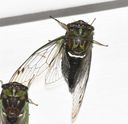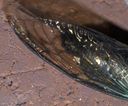Dogday Cicadas
Neotibicen
Classification
- Phylum: Arthropoda
- Subphylum: Hexapoda
- Class: Insecta
- Order: Hemiptera
- Suborder: Auchenorrhyncha
- Infraorder: Cicadomorpha
- Superfamily: Cicadoidea
- Family: Cicadidae
- Subfamily: Cicadinae
- Tribe: Tacuini
- Genus: Neotibicen
Pronunciation
How to pronounce Neotibicen: /ˌniː.oʊˈtɪbɪˌsɛn/
These audio files are automatically generated. While they are not always 100% accurate, they are a good starting point.
Images






Summary
Neotibicen is a genus of cicadas known for their large size and loud songs. They are common in eastern North America, with species appearing every summer, unlike the 13- or 17-year life cycle of periodical cicadas.
Physical Characteristics
Neotibicen cicadas are 1–2 inches (25–51 mm) long, with characteristic green, brown, and black markings on the top of the thorax, and tented, membranous wings extending past the abdomen. The forewings are about twice the length of the hindwings.
Identification Tips
Look for large bodies, distinctive color patterns (green, brown, black), and the presence of tymbal organs on males.
Habitat
Neotibicen cicadas inhabit eastern North America and previously inhabited Bermuda, typically in areas where host plants are present.
Distribution
Primarily in eastern North America, with historical presence in Bermuda.
Diet
Adults feed by tapping into the xylem of plants; nymphs feed on the xylem of roots.
Life Cycle
Neotibicen cicadas likely take multiple years to develop underground, with overlapping generations leading to their annual appearances.
Reproduction
Males produce loud calls to attract females, with distinctive song phrases characteristic of each species.
Predators
One of the notable predators is the cicada killer wasp, which paralyzes cicadas to use as a food source for its larvae.
Ecosystem Role
Neotibicen cicadas serve as a food source for various animals, particularly during their last days of life when they are easier to catch.
Cultural Significance
Common names include cicada, harvestfly, jar fly, and the misnomer locust.
Evolution
In 2015, Neotibicen species were separated from Tibicen and placed in their own genus; several species were moved to other genera as well.
Misconceptions
Often misidentified as locusts, which is incorrect since they belong to different orders of insects.
Tags
- cicada
- insect
- Neotibicen
- Dog Day Cicada